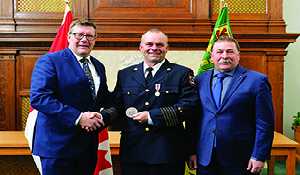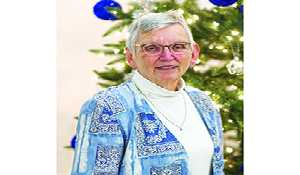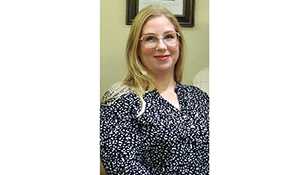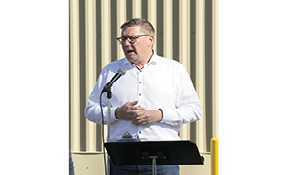Chief Evan Taypotat has big goals for Kahkewistahaw First Nation
June 17, 2024, 10:09 am
Ashley Bochek


Kahkewistahaw First Nation is growing and developing, and Chief Evan Taypotat believes that economic development is the key to further growth and ultimately, sovereignty.
“I was raised on Kahkewistahaw as a young guy in the ‘80s,” he says. “It was just dusty roads. A lot of us were poor at the time, but we didn’t know we were poor. We would go to town once a month for pizza or the odd time we would get some chicken. We would go to town with mushum and kokum every so often on payday, but we just thought that was normal, when in hindsight we were poor. I went to school in Broadview and was bussed in every day.”
Taypotat became a teacher, then joined the Canadian army, fought in Afghanistan, and eventually returned to Kahkewistahaw.
“I left the reserve when I was 18. I enlisted in the army and went to university. I came home to be a teacher in 2005 when I graduated with my BEd from U of S. I taught for two years and then I went to the military for five years. I was all over—in Montreal, Quebec, Camp Gagetown, New Brunswick for my battle school training. Then, I was posted to 1 PPCLI (Princess Patricia’s Canadian Light Infantry) after in Edmonton. Then I went to Afghanistan. Once I realized Afghanistan was over—and I say that in respect to the 158 soldiers who lost their lives in Afghanistan and the people who were injured—but once that war was over I just thought there was no need to be in the army anymore. I came home and was our principal at Chief Kahkewistahaw Community School and I was there for four and a half years. Then, I took this job as chief in May of 2017. I just passed my seven year anniversary of this job. I have been here since May 12, 2017.”
The chief and council work together on improving life in Kahkewistahaw.
“I work with four elected councillors. They make the decisions and I am the spokesperson for them. Together we help govern Kahkewistahaw First Nation. There are 2,333 members worldwide. There is about 750 on the reserve and there are 210 units of housing. Together we make the decisions for Kahkewistahaw and I chair the meetings. Essentially, the four councillors have an agenda and we go over each topic and I will ask for discussion and anyone in favour or opposed. The roles and duties of a chief, in my opinion, should be moving their people toward sovereignty, meaning that we don’t depend on anyone else. Obviously, we depend on the government right now for funding. We depend on a lot of people, the pharmacist in Broadview, the dentist in Melville, the grocery store in Moosomin.
Path to sovereignty
“The path to sovereignty is economic development. You have to make the money. If your economic ventures are good then money is coming in and then you can build more things and do more for your people. You can afford a doctor, you can afford tribal police, you can afford a dentist, but right now we can’t because treaty gives us the bare minimum. It is not covered in treaty to make sure that Kahkewistahaw First Nation or other First Nations have their own doctor or dentist. We know that sovereignty is over there, we see it, we know what it looks like, it means independence. When you think about the community of Moosomin for example, you think that is a good place to live and for Kahkewsitahaw that is where we are aiming because our people deserve that. We deserve to be healthy and wealthy, just like the people of Moosomin.
“We are very progressive right now. If I was to put 74 First Nations of Saskatchewan and rank us, Kahkewistahaw would be in the top five because of the economic ventures we have going and the team we have here. We have a great workforce, we have strong program managers, a strong council. We do a good job together guiding Kahkewistahaw in the right direction.”
Kahkewistahaw is developing land in Saskatoon that Taypotat says should pay dividends for decades.
“Right now, we are developing land in Saskatoon. We bought 60 acres in 2017 right by the airport. We have a gas station there. We are developing more commercial rental units starting in June, four of them. We are also developing the Mamawi Business Centre which will have RBC, lawyers offices, and Indigenous Gaming Regulators (IGRs) main offices will be there. That is the next phase.
“The next phase beyond that is a hotel and convention centre, a hockey rink, and a fast food restaurant. What we want from there is if those businesses are on our property, there is money coming to the First Nation and then we can start providing those services back here.”
Chief Clarence Louie a role model
Taypotat takes inspiration from a BC chief who has led economic development in his nation.
“Chief Clarence Louie, he is a famous chief in Osoyoos BC, and he says, ‘the economic horse will pull the social cart’ so if we can bring money in economically we can start tackling the Residential school effect which is very much alive on our First Nation. There is a lot of trauma here and a lot of drug and alcohol abuse, and some domestic abuse. Our people are hurting and the only way we are going to address those is through programs and services, speaking to psychiatrists, doctors, the things treaty doesn’t cover for us. So, we have to make sure we bring that money in to address those problems.”
Hope for a better future
Taypotat says both the financial benefits of economic development, and the fact that development gives people hope for a brighter future are important.
“I think both are equally important—the money coming in for our people and the people knowing there is more money coming in the future. What I have been telling my people right now, is in 100 years from now when that land in Saskatoon has made us millionaires, no one is going to remember the things we do today, but we still have to make economically sound decisions that are for the greater good of Kahkewistahaw financially, so we are not breaking the bank today because we are trying to plan for the future.
“It took us seven generations to get to where we are today. We are trying to plan for seven generations from today so when I am long gone and my little daughter is a kokum 50 years from now, that her kids and grandkids have the opportunity that we planned for today. That is the goal.”
He said Kahkewistahaw is looking at opportunities in other centres as well.
“We are looking at Regina and Moose Jaw as centres we want to be involved with because those mayors and councillors in those cities see us doing good things in Saskatoon and they want us to be a part of their plan going forward.
“The land in Saskatoon stood for sale since the 1940s because there was no infrastructure there. There was no water lines, power lines, sewer lines, so we have done all of that now and we have shown people that we can get things done.
“Obviously, other cities have mandates to have an Indigenous footprint in their city so they want to pick winners. We have a proven track record in Saskatoon that is enticing to other urban areas.”
“If you look at the richest First Nations in Canada they’re geographically gifted. They’re in or around cities. Out here if I were to build a hotel and casino in Kahkewistahaw there isn’t a lot of traffic out here, but if you build that in Saskatoon by the airport where there is a lot of traffic coming in and out, it’s going to be more successful. That is why we do the urban reserves. It is to make money that we couldn’t make out here.”
He said the first nation does face barriers to development, including racism.
“The number one challenge is racism. My late uncle Denton George, he raised me. He wasn’t allowed at a lot of corporate tables and he was very vocal against the Enbridges, CN rails, the Saskatchewan government, and the Canadian federal government because we weren’t at those tables. Fast forward 2024, now we are at some of those tables, but not all of those tables.
“With Enbridge we sit at the table and they say ‘what do you want for your people, Chief and how can we help protect the environment?’ that is what you want. With The province of Saskatchewan we don’t sit at those tables. In Saskatchewan, some are non-Indigenous and I am Indigenous.
“We are going to be neighbours forever, . I think we should get to know each other and understand each other better, but that divide is there still. You see all of these companies getting super rich with all the natural resources that we don’t really have a say in, that’s racism because we are going to neighbours forever so why wouldn’t we want to be rich and healthy together because health is directly related to wealth and the Non-Indigenous people are richer than my people and in the long-term they are going to be healthier than my people and they are going to live a longer life than we are and that is not right. Our people are treated like second class citizens and live in third-world conditions in some places in a first-world province. That is wrong and that is racism.
“I am optimistic, but there are some people that think if they tweet something nice one day a year that they’re reconciled and they are not, it is just letting the problem fester. We live with Whitewood, Broadview, and Grenfell right here, but we don’t really know each other.”
Optimistic for better understanding
He is optimistic, however.
“We had a school powwow and we saw Broadview School there so it is amazing to see that and it has taken this long to take that happen. So I am optimistic. I think there is an effort by some people to change it, but we need the greater population of Saskatchewan to want to change it because we are going to be neighbours forever and we depend on each other.
“We are going to win some claims coming up in the next 12 months when our people get those dollars we don’t rent a spaceship and go to Mars, we spend our dollars in Moosomin, Kipling, Melville, Churchbridge, Regina, Saskatoon, and I just think that is just being good neighbours and good Saskatchewanites.
“All our opportunities are based on our economic ventures. If our economic ventures go really well then we can go above and beyond. We have a young boy who just made the Team Saskatchewan training team for softball. His name is Spencer MacKay and he is going to have a really good opportunity to be a high-caliber successful player, so we have dollars in our budget now for elite athletes where most First Nations don’t have that though because their economic ventures may not be as great. We are fortunate enough where our economic ventures are doing pretty good so Spencer is going to have a bit of dollars at his disposal.
Growth in Kahkewistahaw
Taypotat says there are many examples of growth on Kahkewistahaw.
“The governance building is an example of the growth on Kahkewistahaw. This building cost us $20 million in 2020. Right now, we are building 15 housing units for families. We are planning to own Maintanance and Operations building and Firehall and then after that we are going to build our hockey arena and our community centre. Next fall we are going to start our own minor hockey program. That is the growth right now. Covid made us think really strong about sustainability. This summer we’ve started a community garden in the middle of the village and next year we are starting our own greenhouse. The plan is in place it is just a matter of making sure we have the dollars, the funding, and capacity.
“I think why we would be developed less than say Moosomin, that’s just a lack of opportunities.
“We don’t worry about the mortgages out here because the reserve owns the houses, but we never were really supposed to be doctors, NHL players, the residential school effect was supposed to squash all of that and get rid of the Indian in the Indian. We are still battling that effect today. The opportunity offered to the non-Indigenous person growing up in Saskatchewan in the 1900s was a lot better than the Indigenous man or woman growing up on a reserve.”
Goals as chief
Taypotat says his goals are sovereignty, and for Kahkewistahaw to be a self-sufficient community.
“As chief, I want to achieve sovereignty. Like all of the surrounding communities who don’t have to go far for different services. In Moosomin, you can pretty much do everything there at home, we want that here in Kahkewistahaw. The goal is to have a sustainable healthy community on Kahkewistahaw First Nation.
“When I was growing up, I graduated in the 90s then, my mushum and kokum said ‘you have to get your grade 12 because you can get a good job,’ it was right around that time it started changing. It then became you needed to get a university degree through the early 2000s, and then it became you needed to get your masters degree and now, we are at the point where Indigenous people are saying, ‘get your doctorate.’ That’s what changing, the Indigenous animal is awakening in us and part of it is Canada is starting to accept that we are here now and that we are going to be here, and we are powerful people.
“We are powerful Cree people that our elders and ancestors fought long for us to stay here. With all the development we are seeing, the education we are achieving, and all the cultural awakening. I think where we will be in the next 20 years will be sovereignty and it will be a beautiful place.
“My mushum and kokum were affected by the residential schools. They were very tough love, but they always just wanted the best for us grandkids and I think if they could see their people and their family today, they would be really proud. We were just raised to be a good people and have good hearts.”



































